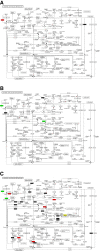Analysis of Phakopsora pachyrhizi transcript abundance in critical pathways at four time-points during infection of a susceptible soybean cultivar using deep sequencing
- PMID: 24025037
- PMCID: PMC3847679
- DOI: 10.1186/1471-2164-14-614
Analysis of Phakopsora pachyrhizi transcript abundance in critical pathways at four time-points during infection of a susceptible soybean cultivar using deep sequencing
Abstract
Background: Phakopsora pachyrhizi, the causal agent responsible for soybean rust, is among the top hundred most virulent plant pathogens and can cause soybean yield losses of up to 80% when appropriate conditions are met. We used mRNA-Seq by Illumina to analyze pathogen transcript abundance at 15 seconds (s), 7 hours (h), 48 h, and 10 days (d) after inoculation (ai) of susceptible soybean leaves with P. pachyrhizi to gain new insights into transcript abundance in soybean and the pathogen at specific time-points during the infection including the uredinial stage.
Results: Over three million five hundred thousand sequences were obtained for each time-point. Energy, nucleotide metabolism, and protein synthesis are major priorities for the fungus during infection and development as indicated by our transcript abundance studies. At all time-points, energy production is a necessity for P. pachyrhizi, as indicated by expression of many transcripts encoding enzymes involved in oxidative phosphorylation and carbohydrate metabolism (glycolysis, glyoxylate and dicarboxylate, pentose phosphate, pyruvate). However, at 15 sai, transcripts encoding enzymes involved in ATP production were highly abundant in order to provide enough energy for the spore to germinate, as observed by the expression of many transcripts encoding proteins involved in electron transport. At this early time-point, transcripts encoding proteins involved in RNA synthesis were also highly abundant, more so than transcripts encoding genes involved in DNA and protein synthesis. At 7 hai, shortly after germination during tube elongation and penetration, transcripts encoding enzymes involved in deoxyribonucleotide and DNA synthesis were highly abundant. At 48 hai, transcripts encoding enzymes involved in amino acid metabolism were highly abundant to provide for increased protein synthesis during haustoria maturation. During sporulation at 10 dai, the fungus still required carbohydrate metabolism, but there also was increased expression of transcripts encoding enzymes involved in fatty acid metabolism.
Conclusion: This information provides insight into molecular events and their timing throughout the life cycle of the P. pachyrhizi, and it may be useful in the development of new methods of broadening resistance of soybean to soybean rust.
Figures





Similar articles
-
Genome-wide annotation of the soybean WRKY family and functional characterization of genes involved in response to Phakopsora pachyrhizi infection.BMC Plant Biol. 2014 Sep 10;14:236. doi: 10.1186/s12870-014-0236-0. BMC Plant Biol. 2014. PMID: 25201117 Free PMC article.
-
Biphasic gene expression changes elicited by Phakopsora pachyrhizi in soybean correlate with fungal penetration and haustoria formation.Plant Physiol. 2011 Sep;157(1):355-71. doi: 10.1104/pp.111.181149. Epub 2011 Jul 26. Plant Physiol. 2011. PMID: 21791600 Free PMC article.
-
Transcriptome-based analyses of phosphite-mediated suppression of rust pathogens Puccinia emaculata and Phakopsora pachyrhizi and functional characterization of selected fungal target genes.Plant J. 2018 Mar;93(5):894-904. doi: 10.1111/tpj.13817. Epub 2018 Feb 6. Plant J. 2018. PMID: 29315949
-
Soybean-Phakopsora pachyrhizi interactions: towards the development of next-generation disease-resistant plants.Plant Biotechnol J. 2024 Feb;22(2):296-315. doi: 10.1111/pbi.14206. Epub 2023 Oct 26. Plant Biotechnol J. 2024. PMID: 37883664 Free PMC article. Review.
-
Phakopsora pachyrhizi, the causal agent of Asian soybean rust.Mol Plant Pathol. 2010 Mar;11(2):169-77. doi: 10.1111/j.1364-3703.2009.00589.x. Mol Plant Pathol. 2010. PMID: 20447267 Free PMC article. Review.
Cited by
-
Reduction of Phakopsora pachyrhizi infection on soybean through host- and spray-induced gene silencing.Mol Plant Pathol. 2020 Jun;21(6):794-807. doi: 10.1111/mpp.12931. Epub 2020 Mar 20. Mol Plant Pathol. 2020. PMID: 32196911 Free PMC article.
-
Resistance to Botrytis cinerea in Solanum lycopersicoides involves widespread transcriptional reprogramming.BMC Genomics. 2014 May 3;15:334. doi: 10.1186/1471-2164-15-334. BMC Genomics. 2014. PMID: 24885798 Free PMC article.
-
Prediction of the in planta Phakopsora pachyrhizi secretome and potential effector families.Mol Plant Pathol. 2017 Apr;18(3):363-377. doi: 10.1111/mpp.12405. Epub 2016 Jun 9. Mol Plant Pathol. 2017. PMID: 27010366 Free PMC article.
-
Fighting Asian Soybean Rust.Front Plant Sci. 2016 Jun 7;7:797. doi: 10.3389/fpls.2016.00797. eCollection 2016. Front Plant Sci. 2016. PMID: 27375652 Free PMC article. Review.
-
Comparative transcriptome analysis and identification of candidate effectors in two related rust species (Gymnosporangium yamadae and Gymnosporangium asiaticum).BMC Genomics. 2017 Aug 23;18(1):651. doi: 10.1186/s12864-017-4059-x. BMC Genomics. 2017. PMID: 28830353 Free PMC article.
References
-
- Lynch TN, Marois JJ, Wright DL, Harmon PF, Harmon CL, Miles MR, Hartman GL. First report of soybean rust caused by Phakopsora pachyrhizi on Phaseolus spp. in the United States. Plant Dis. 2006;90:970. - PubMed
-
- Ono Y, Buritica P, Hennen JF. Delimitation of Phakopsora, Physopella and Cerotelium and their species on Leguminosae. Mycol Res. 1992;96:825–850. doi: 10.1016/S0953-7562(09)81029-0. - DOI
-
- Rytter JL, Dowler WM, Bromfield KR. Additional alternative hosts of Phakopsora pachyrhizi, causal agent of soybean rust. Plant Dis. 1984;68:818–819.
-
- Sconyers LE, Kemerait RC, Brock JH, Gitaitis RD, Sanders FH, Phillips DV, Jost PH. First report of Phakopsora pachyrhizi, the causal agent of Asian Soybean Rust, on Florida beggarweed in the United States. Plant Dis. 2006;90:972. - PubMed
Publication types
MeSH terms
Substances
Grants and funding
LinkOut - more resources
Full Text Sources
Other Literature Sources
Miscellaneous

